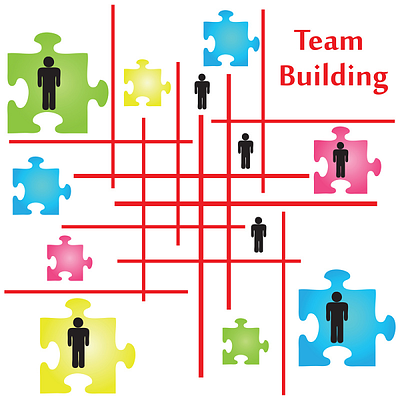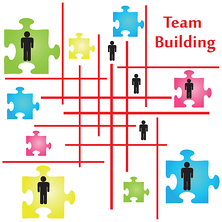CEO Blog - Advice for CEOs on growth and scaling
Overcoming Team Building Resistance

 I am a big believer in teams in a business environment. I don't just meant people working together well, but actively taking steps to know each other as people, form bonds and work with a common purpose. I've always tried to foster a strong team dynamic in the groups I've led, and have taken active steps to create an environment in which those bonds could grow.
I am a big believer in teams in a business environment. I don't just meant people working together well, but actively taking steps to know each other as people, form bonds and work with a common purpose. I've always tried to foster a strong team dynamic in the groups I've led, and have taken active steps to create an environment in which those bonds could grow.
But what to do when the people resist becoming a team?
That was the situation I faced on becoming the new leader of an existing group of marketers with a long history of underachievement. Although many in the group had worked together for years and had known each other even longer, they were decidedly not a team. That's not to say they didn't collaborate or help each other on occasion, but communication was limited, information was closely held, project details and progress was guarded, and requests for details was met with suspicion. It quickly became obvious to me that performance of this loosely connected collection of individuals was never going to improve unless something was done to bring them together. Here’s what we did.
Tips for building a team:
Find evangelists who can help – Several people in the group were hungry for a different approach and recognized the benefits of working in unison. They became our evangelists, and took the lead on communicating with the group, sharing information and working together to encourage the more reluctant members to do the same. They made it safe for other people in the group to begin to trust each other.
Empower and challenge – Our evangelists were empowered to set the agenda for our team building endeavors, coming up with ideas for activities to strengthen our team dynamic. They were not daunted by the challenge of a group scattered in multiple locations, using technology to overcome the distance. They came up with several engagement initiatives, including the establishment of a team page on the microvolunteering site Sparked, complete with common goals which leveraged our individual talents to help worthwhile organizations.
Educate and communicate – Our company had not been known previously for it's openness and transparency. We changed that with frequent updates on our goals and business results (previously a black-box to most). We also rotated the selection of topics for our education and training sessions among the group, which went a long way towards making the meetings “theirs” rather than “mine”.
Extend the team – The company had traditionally been a very closed environment where each group kept to themselves. We changed that by inviting others outside the marketing organization to our meetings and team building events. This allowed us to extend our networks and build stronger working relationships with our business partners in sales, HR, finance, and other areas.
Accept that not everyone will join in – Despite our best efforts, there were some who just never warmed to the team concept. They were always included but never engaged. We kept a close eye out for disruptive or passive-aggressive behavior, but never forced them to participate beyond their level of comfort.
After several months I could see signs that we were finally coming together as a team. Sharing of information improved, trust was growing and collaboration was becoming the norm. Our productivity improved because of it, but more importantly, we became better marketers because we were able to leverage each others' strengths more effectively. And because we were able to build trust outside of marketing, we were able to be better business partners with the rest of the organization.
How do you build a team? Is it important?
Topics: Alignment, Team Building
Tue, Aug 21, 2012Featured Chief Outsider
/cmo-Slade-Kobran.jpg?width=200&height=200&name=cmo-Slade-Kobran.jpg)
Slade Kobran
Related Articles

- Press Releases
- Careers
- Case Studies
- Marketing Consultant Company
- Marketing Strategy Consultants
- Marketing Plan Consultants
- B2B Marketing Consultants
- Virtual CMO
- Marketing Consultant Outsourcing
- Fractional CMO
- What is a Fractional CMO
- Healthcare Marketing Consultant
- Marketing Consultant Houston TX Texas
- Marketing Consultant Texas TX
- Marketing Consultant Bay Area
- CEO Blog
- Ebooks Plus
- Executive Marketing Consultants
- Product Marketing Consultants
- B2C Marketing Consultants
- Virtual Marketing Consultants
- Senior Marketing Consultants
- Temporary CMO
- Hire a CMO
- Fractional CMO Salary
- Fractional CMO Responsibilities
- Marketing Consultant Austin TX Texas
- Marketing Consultant Dallas TX Texas
- Marketing Consultant San Antonio
- Helping Private Equity
- Private Equity Blog
- Leadership Team
- Privacy Policy
- Business Marketing Consultants
- Strategic Marketing Consultants
- Marketing Technology Consultants
- Sales and Marketing Consultants
- CMO Job Description
- CMO Salary
- Fractional CMO Agency
- Fractional CMO Services
- CPG Marketing Consultant
- Marketing Consultant San Diego
- Partners
Houston, TX 77056
© 2023 Chief Outsiders

